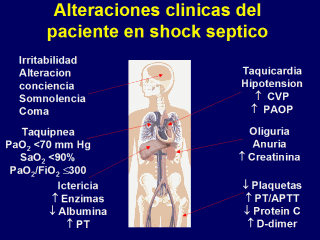| front |1 |2 |3 |4 |5 |6 |7 |8 |9 |10 |11 |12 |13 |14 |15 |16 |17 |18 |19 |20 |21 |22 |23 |24 |25 |26 |27 |28 |29 |30 |31 |32 |33 |34 |35 |36 |37 |review |
 |
Following
identification of a patient with sepsis, the clinician must assess the
patient for the presence of acute organ dysfunction (severe sepsis). The
presence of acute organ dysfunction is often recognized clinically by the
patientís presenting signs and symptoms. However, in some instances
laboratory data or results of invasive monitoring will confirm the diagnosis
of organ dysfunction. The illustration of the patient on this slide has arrows pointing to various organs that might provide clues to the presence of organ dysfunction. Indications of organ dysfunction include: Hematological: thrombocytopenia, abnormal coagulation tests, decreased levels of Protein C, increased D-dimers |